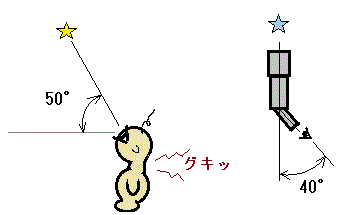
Because the neck of human body is not able to be bent over 60 degrees ,
the eyepiece direction must be bent for over 30 degrees .
Astronomical telescope is used to see
very large area in the sky .The difference between the astronomical
use telescope and the one for landscape viewing is this .
In most cases current astronomical
telescope force user to look through in a painful pose .
I think it is very important to design
the astronomical telescope considering the human body . Because the telescope
is the machine used by human .
Easy
to look through in a comfortable position
Basically we feel pain to bent our
neck to see the sky at the altitude angle of over 60 degrees .
When we watch around the zenith , we
have to throw back our head , strength the our back born , bent the neck
hard .Very hard .
That is the reason why we must use
a refractor telescope with a diagonal prism .
To see the zenith with our neck which
is possible to be bent only until 60 degrees , we should give an incline
of over 30 degrees between the viewing direction of the telescope and
the eyepiece axis. (90-60=30)

We must not forget the significance of the height of the eyepiece . We can't avoid the pain with the inadequate height of the eyepiece even if it has an incline of some degrees .
When we use the 45 degrees inclined
telescope at a hinge consist of one shaft , the height of eyepiece vary
a lot .It exceed the allowance of human body .
If we set the height of eye piece
position to be able to look through the landscape , it goes down too low
to look through comfortably when we see the upper sky .
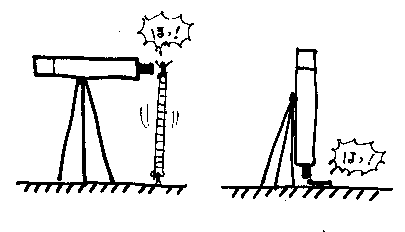
It is necessary to increase the height of eyepiece according to the rise of the altitude angles of the telescope ideally .
Capable
to feel actually the derection where the user watching
We must think about this condition
considering the above condition .
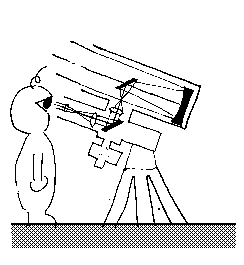 coude type
coude type 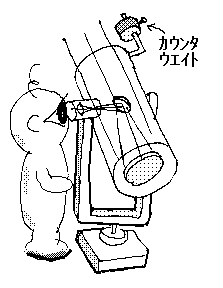 yamazaki
type
yamazaki
type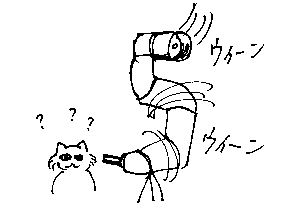
The CCD camera will be used more widely
in the near future which is not necessary to look through the eye piece
any more .So those types with computer control system may not be
so odd in the future .
But I think those types are not so
human . The real ergonomical telescope should give user a feeling to know
where he see naturally .
It must have the static relationship
between the the viewing direction and telescope axis .
Regarding this condition the straight
through pass type is the best . But this type is not easy to look through
in the sky as I explained in the above condition .
As this condition and the above one
are opposed each other so I propose following sub conditions as compromise
.
- The incline of the
eye piece against objective axis is below 60 degrees
- Make something like
a site line near eyepiece
- Make it possible
to get wide field view at low magnification ( If possible over 3 degrees
)
Erect
image
The up side down image of astronomical
telescope is the result not to degrade the optical performance .
Of course the erect image like such
as binoculars is more natural .
User will get used to the movement
of the inverted image of the current telescope . But he must see the star
map up side down in the dark night with small red light .This will make
him confused sometimes .
The mirror image of the diagonal prism
( or diagonal mirror ) is more odd than inverted image . You can hardly
contrast the image with the map or with real star pattern by your bear
eyes .
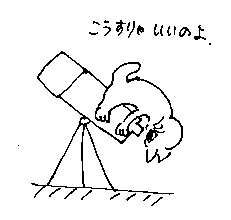
Light
weight
The heavy mounting is more stable and
more effective to keep the telescope away from vibrations .
But many of amateur astronomer must
bring his telescope out of his house to the near dark open space
or into the car .
There is the limitation of the weight
that human can hold .
If the total weight is over 10 kg (
4.5 pounds ) , you will be tired to move it to the near park unless you
pay attention to the way to hold it .
If the total weight is over 20 kg (
9 pounds ) , it is necessary to transport it on a handcart properly speaking
.
The weight of the easy use telescope
must be less than 15 kg ( 6.8 pounds ), if possible , below 10 kg (4.5
pounds ) ideally .
Easy
to construct
If the telescope is not be able to
be in use soon the user will lose his passion to use it .
It is not easy to construct many parts
at the night .
The telescope should be constructed
by only transformation identically . It is not good to assemble the separated
parts in the dark .
The user must give up to assemble his
telescope if he dropped the screw in the bush at night .

Nice
viewing
This condition does not mean a mere
optical or mechanical performance of the telescope but the psychological
expectation .
That is "How does this telescope gives
the user fun to use ?" .
For examples , If it takes 15 minutes
to assemble the 2.4 " telescope ,the user will be disappointed by it's
poor performance .
But if 12" performance telescope require
20 minutes to be constructed ,the user will admit it .
This condition should be called labor
performance or so .
Safety
If the telescope have a obvious possibility
to hurt user ,it is disqualification .
- Eliminate dangerous section ; sharp edge
, bare screw ,etc.
- Safety warning indications ; Never see
the sun , the way to hold , high voltage , etc.
- Not easy to fall down
- Not easy to lose the cap of objective lens
. ( to avoid the accident by the sun light in the day time . )
etc.
They are studying the
ergonomics in the telescope or binocular
Mr.Miyag ....bench
for binoculars (HP linked)
Mr.Tatsuro Matsumoto
...invented the erecting mirror system (HP linked)
Mr.Youichi Kimura .....many
report about ergonomically optics for astronomical binoculars
Mr.Kunio Takagi ....invented
erected mirror system for ordinary binocular
Mr. MItsuji Kaneko
....invented personal capsule type telescope
Mr.Tadasi Kato ....invented
mounting for astronomical binoculars
and Hiroyuki
Yamaguchi.....it is me